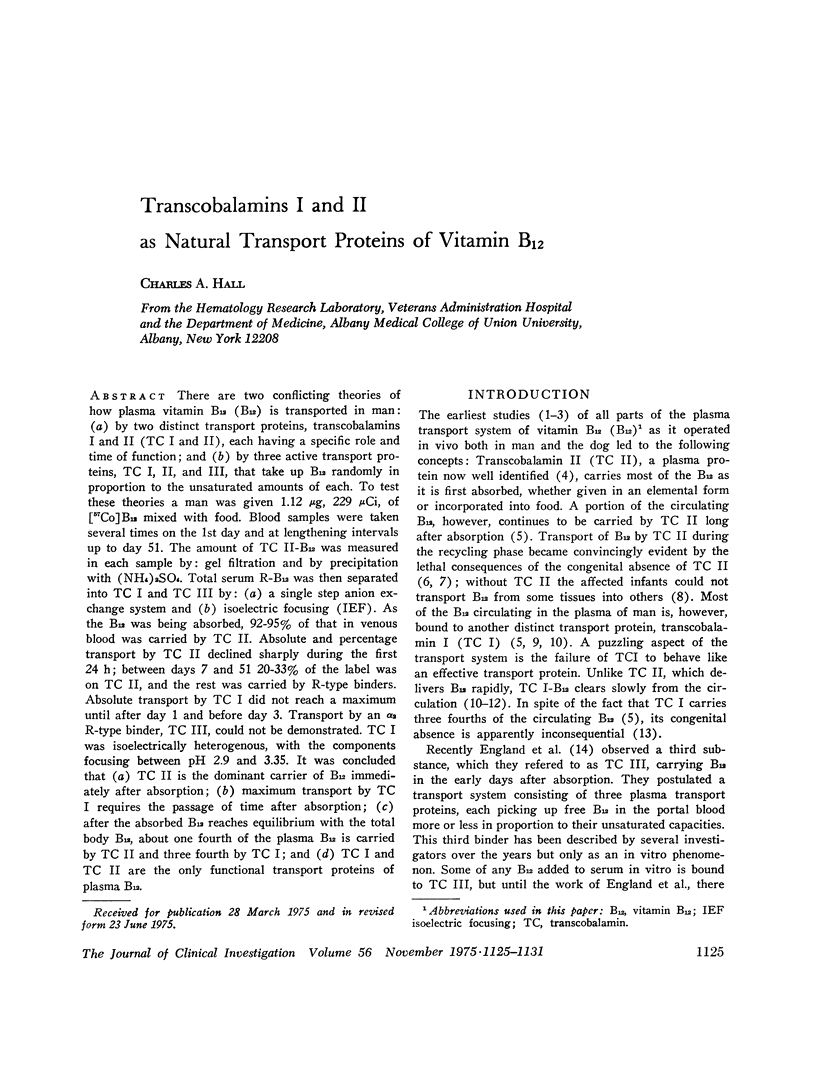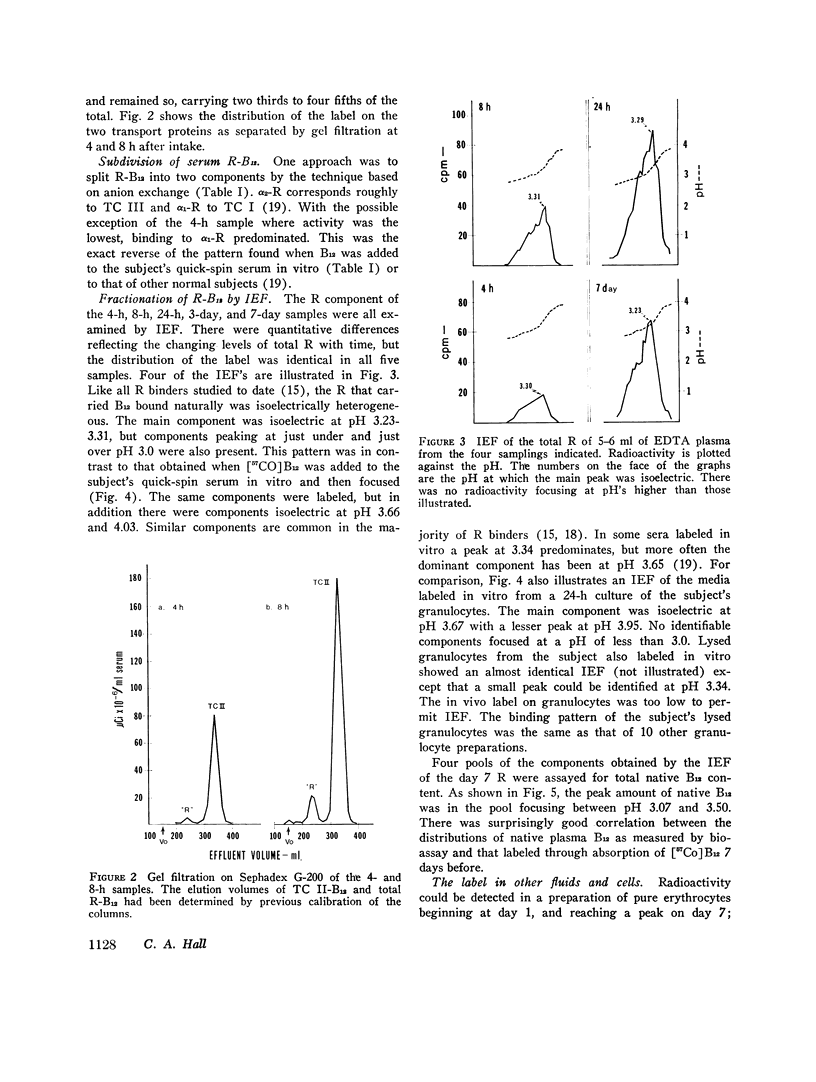Abstract
There are two conflicting theories of how plasma vitamin B12 (B12) is transported in man: (a) by two distinct transport proteins, transcobalamins I and II (TC I and II), each having a specific role and time of function; and (b) by three active transport proteins, TC I, II, and III, that take up B12 randomly in proportion to the unsaturated amounts of each. To test these theories a man was given 1.12 mug, 229 muCi, of [57Co]B12 mixed with food. Blood samples were taken several times on the 1st day and at lengthening intervals up to day 51. The amount of TC II-B12 was measured in each sample by: gel filtration and by precipitation with (NH4)2SO4. Total serum R-B12 was then separated into TC I and TC III by: (a) a single step anion exchange system and (b) isoelectric focusing (IEF). As the B12 was being absorbed, 92-95% of that in venous blood was carried by TC II. Absolute and percentage transport by TC II declined sharply during the first 24 h; between days 7 and 51 20-33% of the label was on TC II, and the rest was carried by R-type binders. Absolute transport by TC I did not reach a maximum until after day 1 and before day 3. Transport by an alpha2 R-type binder, TC III, could not be demonstrated. TC I was isoelectrically heterogenous, with the components focusing between pH 2.9 and 3.35. It was concluded that (a) TC II is the dominant carrier of B12 immediately after absorption; (b) maximum transport by TC I requires the passage of time after absorption; (c) after the absorbed B12 reaches equilibrium with the total body B12, about one fourth of the plasma B12 is carried by TC II and three fourth by TC I; and (d) TC I and TC II are the only functional transport proteins of plasma B12.
Full text
PDF






Selected References
These references are in PubMed. This may not be the complete list of references from this article.
- Allen R. H., Majerus P. W. Isolation of vitamin B12-binding proteins using affinity chromatography. 3. Purification and properties of human plasma transcobalamin II. J Biol Chem. 1972 Dec 10;247(23):7709–7717. [PubMed] [Google Scholar]
- Allen R. H., Majerus P. W. Isolation of vitamin B12-binding proteins using affinity chromatography. II. Purification and properties of a human granulocyte vitamine B12-binding protein. J Biol Chem. 1972 Dec 10;247(23):7702–7708. [PubMed] [Google Scholar]
- Begley J. A., Hall C. A. Measurement of vitamin B12-binding proteins of plasma. I. Technique. Blood. 1975 Feb;45(2):281–286. [PubMed] [Google Scholar]
- Benson R. E., Rappazzo M. E., Hall C. A. Late transport of vitamin B 12 by transcobalamin II. J Lab Clin Med. 1972 Oct;80(4):488–495. [PubMed] [Google Scholar]
- Burger R. L., Allen R. H. Characterization of vitamin B12-binding proteins isolated from human milk and saliva by affinity chromatography. J Biol Chem. 1974 Nov 25;249(22):7220–7227. [PubMed] [Google Scholar]
- Carmel R., Herbert V. Deficiency of vitamin B12-binding alpha globulin in two brothers. Blood. 1969 Jan;33(1):1–12. [PubMed] [Google Scholar]
- England J. M., Clarke H. G., Down M. C., Chanarin I. Studies on the transcobalamins. Br J Haematol. 1973 Dec;25(6):737–749. doi: 10.1111/j.1365-2141.1973.tb01786.x. [DOI] [PubMed] [Google Scholar]
- Finkler A. E., Green P. D., Hall C. A. Immunological properties of human vitamin B 12 binders. Biochim Biophys Acta. 1970 Jan 20;200(1):151–159. doi: 10.1016/0005-2795(70)90053-x. [DOI] [PubMed] [Google Scholar]
- Gizis E. J., Arkun S. N., Miller I. F., Choi G., Dietrich M. F., Meyer L. M. Plasma clearance of transcobalamin I- and transcobalamin II-bound Co57 vitamin B 12. J Lab Clin Med. 1969 Oct;74(4):574–580. [PubMed] [Google Scholar]
- HALL C. A., FINKLER A. E. A SECOND VITAMIN B12-BINDING SUBSTANCE IN HUMAN PLASMA. Biochim Biophys Acta. 1963 Oct 8;78:234–236. doi: 10.1016/0006-3002(63)91633-0. [DOI] [PubMed] [Google Scholar]
- HALL C. A., FINKLER A. E. THE DYNAMICS OF TRANSCOBALAMIN II. A VITAMIN B12 BINDING SUBSTANCE IN PLASMA. J Lab Clin Med. 1965 Mar;65:459–468. [PubMed] [Google Scholar]
- HALL C. A. LONG- TERM EXCRETION OF CO-57-VITAMIN B12 AND TURNOVER WITHIN THE PLASMA. Am J Clin Nutr. 1964 Mar;14:156–162. doi: 10.1093/ajcn/14.3.156. [DOI] [PubMed] [Google Scholar]
- Hakami N., Neiman P. E., Canellos G. P., Lazerson J. Neonatal megaloblastic anemia due to inherited transcobalamin II deficiency in two siblings. N Engl J Med. 1971 Nov 18;285(21):1163–1170. doi: 10.1056/NEJM197111182852103. [DOI] [PubMed] [Google Scholar]
- Hall C. A. Editorial: Congenital disorders of vitamin B12 transport and their contribution to concepts. Gastroenterology. 1973 Oct;65(4):684–686. [PubMed] [Google Scholar]
- Hall C. A., Finkler A. E. Function of transcobalamin II: a B-12 binding protein in human plasma. Proc Soc Exp Biol Med. 1966 Oct;123(1):55–58. doi: 10.3181/00379727-123-31400. [DOI] [PubMed] [Google Scholar]
- Harrison R. J. Vitamin B12 levels in erythrocytes in anaemia due to folate deficiency. Br J Haematol. 1971 Jun;20(6):623–628. doi: 10.1111/j.1365-2141.1971.tb00800.x. [DOI] [PubMed] [Google Scholar]
- Hitzig W. H., Dohmann U., Pluss H. J., Vischer D. Hereditary transcobalamin II deficiency: clinical findings in a new family. J Pediatr. 1974 Nov;85(5):622–628. doi: 10.1016/s0022-3476(74)80503-2. [DOI] [PubMed] [Google Scholar]
- Hom B. L. Plasma turnover of 57cobalt-vitamin B12 bound to transcobalamin I and II. Scand J Haematol. 1967;4(5):321–332. doi: 10.1111/j.1600-0609.1967.tb01633.x. [DOI] [PubMed] [Google Scholar]
- MENDELSOHN R. S., WATKIN D. M., HORBETT A. P., FAHEY J. L. Identification of the vitamin B12-binding protein in the serum of normals and of patients with chronic myelocytic leukemia. Blood. 1958 Aug;13(8):740–747. [PubMed] [Google Scholar]
- ROSENTHAL H. L. The uptake and turnover of radioactive vitamin B12 in rabbit tissues. J Nutr. 1959 Jun 10;68(2):297–311. doi: 10.1093/jn/68.2.297. [DOI] [PubMed] [Google Scholar]
- Rappazzo M. E., Hall C. A. Cyanocobalamin transport proteins in canine plasma. Am J Physiol. 1972 Jan;222(1):202–206. doi: 10.1152/ajplegacy.1972.222.1.202. [DOI] [PubMed] [Google Scholar]
- Stenman U. H. Characterization of R-type vitamin B12-binding proteins by isoelectric focusing. I. The relationship between transcobalamin I, transcobalamin III and the granulocyte R protein. Scand J Haematol. 1974;13(2):129–134. doi: 10.1111/j.1600-0609.1974.tb00246.x. [DOI] [PubMed] [Google Scholar]
- Stenman U. H., Gräsbeck R. Gradients for isoelectric focussing at low pH. Biochim Biophys Acta. 1972 Dec 29;286(2):243–251. doi: 10.1016/0304-4165(72)90261-9. [DOI] [PubMed] [Google Scholar]


